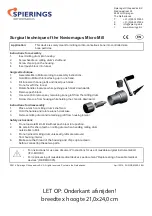
7
Residual risks.
Additional residual risks may arise when using the
tool which may not be included in the enclosed safety
warnings. These risks can arise from misuse, pro-
longed use etc.
Even with the application of the relevant safety regula-
tions and the implementation of safety devices, certain
residual risks can not be avoided. These include:
♦
Injuries caused by touching any rotating/mov-
ing parts.
♦
Injuries caused when changing any parts,
blades or accessories.
♦
Injuries caused by prolonged use of a tool.
When using any tool for prolonged periods
ensure you take regular breaks.
♦
Impairment of hearing.
♦
Health hazards caused by breathing dust
developed when using your tool (example:-
working with wood, especially oak, beech and
MDF.)
Vibration
The declared vibration emission values stated in the
technical data and the declaration of conformity have
been measured in accordance with a standard test
method provided by EN 60745 and may be used for
comparing one tool with another. The declared vibra-
tion emission value may also be used in a preliminary
assessment of exposure.
Warning!
The vibration emission value during actual
use of the power tool can differ from the declared value
depending on the ways in which the tool is used. The
vibration level may increase above the level stated.
When assessing vibration exposure to determine
safety measures required by 2002/44/EC to protect
persons regularly using power tools in employment, an
estimation of vibration exposure should consider, the
actual conditions of use and the way the tool is used,
including taking account of all parts of the operating
cycle such as the times when the tool is switched off
and when it is running idle in addition to the trigger time.
Labels on tool
The following pictograms are shown on the tool:
Warning!
To reduce the risk of injury, the user
must read the instruction manual.
Wear safety glasses or goggles when operat-
ing this tool.
Wear ear protection when operating this tool.
Electrical safety
This tool is double insulated; therefore no
earth wire is required. Always check that the
power supply corresponds to the voltage on
the rating plate.
♦
If the supply cord is damaged, it must be re-
placed by the manufacturer or an authorised
Black & Decker Service Centre in order to avoid
a hazard.
Features
This tool includes some or all of the following features.
1. Slider
switch
2. Cable
3. Keyless
guard
4. Body
grip
5. Side handle (3 positions)
6. Spindle lock button
Assembly
Warning!
Before assembly, make sure that the tool is
switched off and unplugged.
Fitting and removing the guard (
fi
g. B&C)
The tool is supplied with a guard (3) intended for
grinding purposes only. If the unit is intended to per-
form cutting off operations, a guard speci
fi
c for this
operation must be
fi
tted. A suitable guard for cutting
off operations is available and can be obtained from
Black & Decker service centers.
Fitting
♦
Place the tool on a table, with the spindle facing
up.
♦
Release the clamping lock (7) and hold the guard
(3) over the tool as shown.
♦
Align the lugs (8) with the notches (9).
♦
Press the guard down and rotate it counterclock-
wise to the required position.
♦
Fasten the clamping lock to secure the guard to
the tool.
♦
If required, tighten the screw (10) to increase the
clamping force.
Removing
♦
Release the clamping lock (7).
♦
Rotate the guard clockwise to align the lugs (8)
with the notches (9).
♦
Remove the guard from the tool.
Warning!
Never use the tool without the guard.
Fitting the side handle
♦
Screw the side handle (5) into one of the mounting
holes in the tool.
Warning!
Always use the side handle.
Fitting and removing grinding or cutting
discs (
fi
g. D - F)
Always use the correct type of disc for your application.
Always use discs with the correct diameter and bore
size (see technical data).
Fitting
♦
Fit the guard as described above.
♦
Place the inner
fl
ange (11) onto the spindle as
shown (
fi
g. D). Make sure that the
fl
ange is cor-
rectly located on the
fl
at sides of the spindle.






































